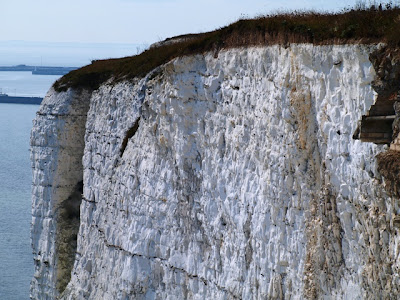The algal cliffs of Dover
I knew the White Cliffs of Dover were the calcareous remains of some ancient sea creature. I was pretty sure that creature was a coccolithophorid, one of the microscopic algae I learnt about at university. Both facts were confirmed yesterday: one from a sign at Dover, the other from a Google search (clearly I could have done both from my arm chair but that wouldn't have been as much fun).
Cocolithophorids (or Cocolithophores or Haptophytes) convert sunlight and carbon dioxide into sugars and oxygen (they are are photosynthetic) so I call them algae. 'Algae', as I've said before, is a category of convenience. It includes more variety than in the rest of the heavens and Earth, well almost.
In this case the alga is one of those fascinating beasts that resulted from at least two endosymbiotic events. What's that you ask? Well the green algae and plant branch of the tree of life began when one bacterium 'swallowed up' another bacterium, the latter being photosynthetic (what we call a cyanobacterium or blue-green alga). In the case of coccolithophorids, that original green algal cell was swallowed up by another so we have what is called a secondary symbiosis. If you can face it, take a look at this diagram which I think I borrowed from an algal journal some years back.
So that's how the coccolithophorids began. They've had, and have, a big impact on Earth. The most common coccolithophorid is Emilania huxleyi, sometimes called plain old Ehux. Thomas Huxley was the first person to see coccolithophorids in sea mud and coined the term 'coccolith' for the calcareous sheilds.
The cells of Ehux, like all coccolithophorids, are protected with little sheilds called coccoliths, and these coccoliths are made of calcium carbonate.
According to my sources (see below) Ehux is the most common and widespread coccolithophorid on Earth. If occurs in oceans everywhere except near the Poles. Milky turquoise blooms of Ehux can cover 100,000 square kilometres, the size of England! The blooms contain not only living cells of Ehux covered in coccoliths, but lots of free-floating coccoliths shed from the cells.
These coccoliths sink to bottom of the sea as they have done for millions of years. In fact the Cretaceous period (145 to 65 million years ago), when most of the flowering plants evolved, was named after the coccolithophorid (chalk) deposits around Paris called Terrain crétacé.
And there's more. The coccolith deposits are a good way to store carbon and keep it out of the atmosphere. The blooms themselves also reflect light and heat back into space and help keep the ocean cooler. So cococcolithophorids have been, and will be, important in how oceans respond to global warming.
Images & further information: Ehux photographed through a scanning electron microscope, then tinted, from Jeremy Young's Portal to Protistology. Most information from Emiliania huxleyi Home Page, linked to University of Southampton website. The cliffs are my own, but Lynda Entwisle took the one to the left.





Comments